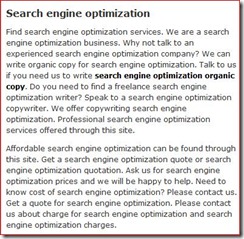I’ve often talked about the importance of search engine optimisation when creating website copy.
Keyword stuffing is a frequent practice that was done to try and attract the search engine spiders. Web site owners researched their keywords and simply used them as many times as possible within their text.
The hope was that the search spiders would jump for joy because of the number of keywords. And the site would then appear in the top listings because it was deemed highly relevant.
That might have been the hope but the reality was somewhat different. Although sites like these may well have achieved good rankings, their conversion rates were lower than half the teenagers trousers are these days.
The problem is that stuffing your copy with keywords renders it unreadable to people. If they can’t read it or it doesn’t make sense, they’re not going to hang around.
A classic example of this was recently highlighted in one of Nikki Pilkington’s tweets:
This has come from an actual site – a copywriting site! This single snippet contains the phrase ‘search engine optimisation’ no less than 17 times!!!!
Eek! Now do you see what I mean by unreadable?
This is an extreme example and I find it unbelievable that any copywriter would think that this sample of their ‘writing talent’ would convince a client to buy their services.
SEO done correctly will look like normal text. The keywords may not even be obvious because they appear naturally within the copy. After all if you sell orange dog collars, the likelihood is that that phrase is going to pop into your copy anyway.
The position of your keywords is far more important than their frequency.
SEO is a game
The game of SEO is about playing by Google’s rules to achieve good rankings. It’s about patience and research – things won’t happen over night. And above all it’s about understanding what your customer wants.
Unlike other marketing methods that are pushed in front of the reader (such as adverts, newsletters etc.), you can’t push your website in front of someone. Instead you have to make it attractive enough for them to find it.
Therefore you have to understand them and work out what they are searching for. Then, and only then, can you optimise your site and continue tweaking until you get great rankings.
Why do you need to know this?
Don’t get ripped off. If you approach a freelance copywriter to help you with your on page SEO, check out their website:
- Do they rank for their keywords? (if you found them through a Google search and are in the organic listings rather than sponsored links, the answer is yes)
- Is their site readable?
- Do they understand SEO?
- Do they ask you for your keywords?
If you answer no to any of the above they probably aren’t right for you.
If they start harping on about keyword density and their site looks like the one above, run away as fast as you can.
SEO copywriting is an art as much as it is a science – make sure you hire someone who is a Jedi Master in both.







1 comment so far ↓
The example you chose is downright funny yet unbelievably sad. I have seen quite a lot of those but this one come from a copywriting site. Oh my!
Leave a Comment